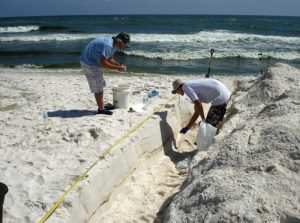Impact of Deepwater Horizon Oil On Beach Microbial Communities
– March 6, 2015
When oil from the Deepwater Horizon spill first began washing ashore on Pensacola Municipal Beach in June 2010, populations of sensitive microorganisms, including those that capture sunlight or fix nitrogen from the air, began to decline.
(From ScienceDaily) — At the same time, organisms able to digest light components of the oil began to multiply, starting the process of converting the pollutant to carbon dioxide and biomass.
Once the lightest fractions of the oil had been consumed, the organisms that had been digesting those compounds declined, replaced by others able to chew up the remaining heavier materials. Ultimately, a year after the spill, the oil had mostly disappeared and microbial populations buried in the beach sands looked much like they had before the spill, though there were as-yet unexplained differences.
That’s the scenario observed by scientists who have studied the oil’s impact on the complex microbial communities — which contain hundreds of single-celled organisms — on this one Gulf Coast beach. Using advanced genomic identification techniques, they saw a succession of organisms and identified population changes in specific organisms that marked the progress of the bioremediation. They also identified the specific genes contained in the oil-eating microbes and the enzymes they used at different stages of the process.
The research, reported online February 17 in The ISME Journal, could help scientists better understand the microbial succession process that results from such environmental perturbations, and perhaps lay the groundwork for research aimed at accelerating bioremediation. The project represents a collaboration between professors at the Georgia Institute of Technology and Florida State University: Kostas Konstantinidis from the Georgia Tech School of Civil and Environmental Engineering, Joel Kostka from the Georgia Tech School of Biology, and Markus Huettel, professor of Earth, Ocean and Atmospheric Sciences at Florida State.
The research was supported by the National Science Foundation, and by the BP/Gulf of Mexico Research Initiative to the Deep-C Consortium.
Read the full article here: http://www.sciencedaily.com/releases/2015/02/150217154038.htm
GoMRI “In the news” is a reposting of articles about GoMRI-funded research (published by various news outlets). The author’s interpretations and opinions expressed in these articles is not necessarily that of GoMRI.






